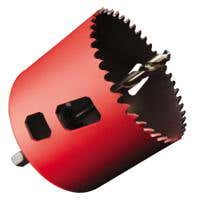Hot Tapper, Bi-Metal Hole Saws
Bi-metal hole saws are versatile equipment used to cut precise holes in a variety of materials, including aluminum, brass, mild steel, and stainless steel. Their unique tooth set design allows for quick and smooth metal cutting with minimal vibration.
The unique cap design minimizes runout and vibration for more precise results. These hole saws, made with superior M42 high-speed steel and 8% cobalt, are more durable than others, lasting more than twice as long.
Features and Benefits
- Metal Cutting Hole Saws with Tooth Set Design - Optimized to Remove Material Faster
- Bi Metal hole saws are compatible with a wide variety of materials including aluminum, brass, mild steel, stainless steel. It also cutsfaster and smoother and with reduced vibration due to the variable pitched teeth.
- New cap - Reduces Runout and Vibration
- Premium M42 High Speed Steel Cutting Edge, 8% COBALT - Over 2X the Life of other types
- Cutting Depth - 1-15/16" (49.2 mm)
- Heavy Duty Hole Saw - .050 Side Wall For Greater Stability
- Side Slot - Increased Leverage for Faster, Easier Slug Removal
- Exterior Red Coating - Reduces Side Wall Friction for Efficient Cutting

| Image | Description | Shipping Wt. | Item Number | Price | Qty | Action |
|---|---|---|---|---|---|---|

|
Saw, Hole 5-1/2" Bi-Metal Deep Cut | 1.5 Lb ( 0.68Kg) | 910-9091- |
$200.20
|
||

|
Saw, Hole 4-3/4" Bi-Metal | 1.5 Lb (0.68 Kg) | 910-9089- |
$117.70
|
||

|
Saw, Hole 3-7/8" Bi-Metal | 1.5 Lb (0.68 Kg) | 910-9087- |
$56.10
|
||

|
Saw, Hole 3-3/8" Bi-Metal | 1 Lb (0.45 Kg) | 910-9085- |
$45.10
|
||

|
Saw, Hole 2-7/8" Bi-Metal | 1 Lb (0.23 Kg) | 910-9084- |
$34.10
|
||

|
Saw, Hole 2-3/8" Bi-Metal | 1 Lb (0.45 Kg) | 910-9083- |
$28.60
|
||

|
Saw, Hole 1-7/8" Bi-Metal | 0.5 Lb (0.23 Kg) | 910-9081- |
$23.10
|
||

|
Saw, Hole 1-3/8" Bi-Metal | 0.5 Lb (0.23 Kg) | 910-9071- |
$18.70
|
||

|
Saw, Hole 1-1/8th Bi-Metal | 0.5 Lb (0.23 Kg) | 910-9061- |
$17.60
|
||

|
Saw, Hole 7/8" Bi-Metal | 0.5 Lb (0.23 Kg) | 910-9041- |
$16.50
|
||

|
Saw, Hole 5/8" Bi-Metal | 0.5 Lb (0.23 Kg) | 910-9031- |
$16.50
|
How to choose the right Hole Saw for Metal Cutting?
Selecting the right hole saw is critical for achieving the best results in your cutting projects. The right hole saw provides clean, precise cuts and improves efficiency and tool life. With so many different types of hole saws available in the market and each one is built for a certain material and use, it is an important decision to choose the correct hole saw.
Here are key factors to consider when choosing a hole saw:
- Material Compatibility – First of all, identify the material you want to cut using a hole saw. Different types of hole saws perform better with certain materials so it is important to consider the material compatibility. For example, Bi-Metal hole saws are ideal for for aluminum, brass, mild steel, and stainless steel. While, Carbide hole saws are suitable for tough materials like stainless steel, cast iron, and cement board.
- Hole Size Requirements – Determine the diameter and depth of the hole you need to cut. Hole saws available in a variety of sizes, so choose one that fits your requirements. Check that the hole saw's cutting depth is sufficient for your project to ensure accurate and efficient results.
- Tooth Design and Construction - Check the tooth design and material of the hole saw. Bi-metal hole saws feature a tooth set designed for quick and smooth cutting with minimal vibration. Carbide hole saws with tungsten carbide teeth are durable and wear-resistant, making them ideal for cutting hard materials.
By considering these factors, you can select the best hole saw for your needs, ensuring precise, efficient, and long-lasting results.
Safety Tips for Using Hole Saws
It is important to use Hole saws safely for efficient metal cutting and avoiding accidents. Follow these safety tips while using Hole saws to protect yourself and get the ideal results:
- Wear Appropriate Safety Gear – When you are using a hole saw, always wear safety goggles and gloves. Wearing googles will protect your eyes from flying debris and the gloves helps to provide a firm grip and protect your hands from sharp edges and hot surfaces.
- Secure the material - Make sure the material you are cutting is firmly secured. To avoid movement while metal cutting using hole saws, use clamps or a vice. This stability reduces the possibility of slipping and delivers a clean, precise cut.
- Inspect the Work Area - Thoroughly evaluate the work space for any hazards such as electrical circuits, plumbing, waste, and trip risks. Before you start the work, make sure that the surroundings are clean and safe.
- Use Light Pressure and Cut Straight – When using hole saw for cutting, apply light and constant pressure to make sure your cuts are straight. This helps to maintain control and keeps the tool from binding or overheating.
- Avoid Unsafe Practices - Don't use a damaged or bent hole saw. Avoid cutting near electrical circuits, ladders, and unstable surfaces. Avoid cutting curved or uneven surfaces, and ensure your drill has an on/off switch.
FAQs
- Can I use a bi-metal hole saw for cutting stainless steel?
Yes, bi-metal hole saws are designed to cut through a variety of materials which includes stainless steel, aluminum, and other metals. Their sturdy design provides durability and precision which makes them ideal choice for heavy-duty and detailed cutting operations. - How deep can bi-metal hole saws cut?
Bi-metal hole saws typically have a cutting depth of up to 1-15/16 inches (49.2 mm). Just make sure that the hole saw you choose meets the depth requirements for your specific project. - What materials are best suited for carbide hole saws?
Carbide hole saws are ideal for cutting tough and abrasive materials including stainless steel, cast iron, cement board, and other hard materials. These hole saws offer the best wear resistance and are designed for heavy-duty applications. - Can carbide hole saws be used on aluminium and brass?
No, carbide hole saws are not suitable for cutting aluminum, brass, mild steel, stainless steel, ceramic, marble, glass, granite, slate, or terrazzo. They are meant for more abrasive materials.
References





